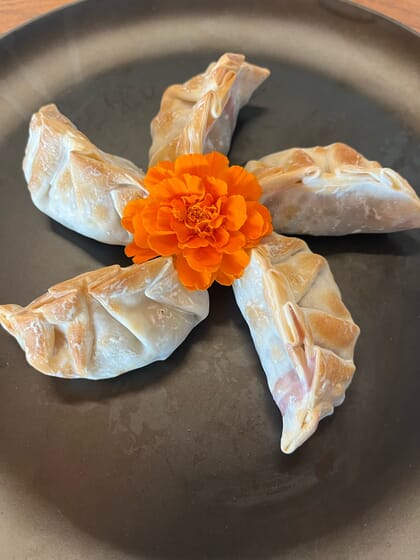
© Aqua Cultured Foods
One filling option uses the startup’s alternative shrimp in a bulk, unseasoned format for partners specialising in Asian foods – including retail and foodservice distributors, to customise their preparations – which then can be packaged and co-branded.
Also known as mandu, jiaozi, or gyoza, dumplings are a dietary staple in countries like South Korea, China and Japan – as beloved as burgers are to North Americans. The global market for frozen dumplings was US $5.825 billion in 2020, and is expected to rise to more than $10 billion by the end of 2027.
“While Aqua’s R&D focus has been on whole-muscle cut, sushi-quality filets with the same visual appeal of high-grade fish, dumplings can use off-cuts, trims and less than visually perfect fillets for minced fillings. Achieving the proper size and texture for filling can also be done economically at scale in large batches, and requires less fermentation time,” said the company in a press release.
“We’re glad our partners challenged us to work on dumplings, and lucky to have their guidance through the process of perfecting the taste and filling for Asian palates,” said Aqua chief growth officer Brittany Chibe. “I’m especially happy that this product moves us closer to zero-waste by finding use for our off-cuts, with the added bonus that it’s very efficient to make in volumes appropriate for foodservice.”
According to the company, other alt-seafood varieties are likely to follow for applications – including spicy tuna sushi rolls, seafood cakes/patties, ravioli and cannelloni.
Aqua is developing mycoprotein-based calamari, shrimp, scallops, and fillets of animal-free tuna and whitefish with a realistic taste and texture. Aqua’s fermentation methods do not use any animal inputs, genetic altering or modification, and can be marketed as non-GMO. Unlike plant-based processed foods formulated with starches and protein isolates, Aqua’s alt-seafood retains its naturally occurring fibre, protein, and other micronutrients.
Aqua has recently showcased its alt-seafood for current and prospective partners representing Europe, Asia, and North America. Public tasting events will gauge consumer acceptance later this year with select restaurant partners, followed by in-market product introductions via strategic partners in 2023.


